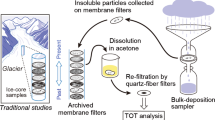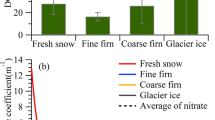Abstract
Carbonaceous particles concentrations of OC and EC are determined using a two-step gas chromatography system in Muztagh Ata ice core covering the time period of 1955–2000. Over the period represented by the core, OC and EC concentrations appear to have changed significantly, varied in the range of 17.7–216.7 and 6.5–124.6, and averaged 61.8, 32.9 ng·g−1, respectively. The average concentration of EC in Muztagh Ata ice core is much lower than that in an Alpine ice core record (100–300 ng·g−1) during the same period, but it is a factor of 14 in Greenland ice core (2.3 ng·g−1), this may induce a strong impact on the snow albedo in the last 46 years in our study area. Observations indicate two periods with obviously high deposition concentrations (1955–1965 and 1974–1989) and two periods with low concentrations (1966–1973 and 1990–1995), as well as a recent increasing trend. By comparing EC and SO 2−4 concentration variations and deciphering OC/EC ratios recorded in the same ice core, we can judge roughly that the carbonaceous particles deposited in Muztagh Ata ice core were attributed to fossil fuel combustion sources.
Similar content being viewed by others
References
Etheridge D M, Pearman G I, Fraser P J. Changes in tropospheric methane between 1841 and 1978 from high accumulation-rate Antarctic ice core. Tellus, 1992, 44B: 282–294
Etheridge D M, Steele L P, Francey R J, et al. Atmospheric methane between 1000 A.D. and present: Evidence of anthropogenic emissions and climatic variability. J Geophys Res, 1998, 103(D13): 15979–15993
Lavanchy V M H, Gaggeler H W, Schotterer U, et al. Historical record of carbonaceous particle concentrations from a European High-alpine glacier (Colle Gnifetti, Switzerland). J Geophys Res, 1999, 104(D17): 21227–21236
Novakov T, Ramanathan V, Hansen J E, et al. Large historical changes of fossil-fuel black carbon aerosols. Geophys Res Lett, 2003, 30(6), 1324, doi:10.1029/2002GL016345
Wang C. A modeling study on the climate impacts of black carbon aerosols. J Geophys Res, 2004, 109, D03106, doi:10.1029/2003JD004084
Jacobson M Z. Strong radiative heating due to the mixing state of black carbon in atmospheric aerosol. Nature, 2001, 409: 695–697
Hansen J E, Sato M. Trends of measured climate forcing agents. Proc Natl Acad Sci USA, 2001, 98(26): 14778–14783
Birch M E, Cary R A. Elemental carbon-based method for monitoring occupational exposures to particulate diesel exhaust. Aerosol Sci Technol, 1996, 25(3): 221–241
Chow J C, Watson J G, Pritchett L C, et al. The DRI Thermal/Optical reflectance carbon analysis system: Description, evaluation, and applications in U.S. air quality studies. Atmos Environ, 1993, 27A(8): 1185–1201
Jacobson M Z. Climate response of fossil fuel and biofuel soot, accounting for soot’s feedback to snow and sea ice albedo and emissivity. J Geophys Res, 2004, 109, D21201, doi:10.1029/2004JD004945
Seinfeld J H, Pandis S N. Atmospheric chemistry and physics: From Air Pollution to Climate Change. New York: John Wiley & Sons, 1998
Lohmann U, Feichter J. Global indirect aerosol effects: a review. Atmos Chem Phys, 2005, 5(3): 715–737
Hansen J E, Sato M, Ruedy R. Radiative forcing and climate response. J Geophys Res, 1997, 102(D6): 6831–6864
Johnson B T. The semi-direct aerosol effect. Doctor Dissertation. Reading: University of Reading, 2003
Hansen J E, Nazarenko L. Soot climate forcing via snow and ice albedos. Proc Natl Acad Sci USA, 2004, 101(2): 423–428
Barnett T P, Adam J C, Lettenmaier D P. Potential impacts of a warming climate on water availability in snow-dominated regions. Nature, 2005, 438: 303–309
Mayol-Bracero O L, Kirchstetter T W, Novakov T. Carbonaceous aerosols over the Indian Ocean during the Indian Ocean Experiment (INDOEX): Chemical characterization, optical properties, and probable sources. J Geophys Res, 2002, 107(D19), 8030, doi:10.1029/2000JD000039
Penner J E. Carbonaceous aerosols influencing atmospheric radiation: black and organic carbon. In: Charlson R J, Heintzengerg J, eds. Aerosol Forcing of Climate: Report of the Dahlem Workshop on Aerosol Forcing of Climate, 1994 April 24–29, Berlin. Chichester: John Wiley & Sons, 1995. 91–108
IPCC. Climate Change 2007: The physical science basis. Contribution of Working Group I to the Fourth Assessment Report of the Intergovernmental Panel on Climate Change. Cambridge: Cambridge University Press, 2007
IPCC. Climate Change 2001: The physical science basis. Contributions of Working Group I to the Third Assessment Report of the Intergovernmental Panel on Climate Change. Cambridge: Cambridge University Press, 2001
Hansen J, Bond T, Cairns B, et al. Carbonaceous aerosols in the industrial era. Eos Trans AGU, 2004, 85(25): 241–244
Warren S G, Clarke A D. Soot in the atmospheric and snow surface of Antarctica. J Geophys Res, 1990, 95(D2): 1811–1816
McConnell J R, Edwards R, Kok G L et al. 20th century industrial black carbon emission altered Arctic climate forcing. Science, 2007, 317: 1381–1384
Xu B Q, Yao T D, Liu X Q, et al. Elemental and organic carbon measurements with a two-step heating-gas chromatography system in snow samples from the Tibetan Plateau. Ann Glaciol, 2006, 43(1): 257–262
Liu X Q, Wang N L, Yao T D, et al. Carbonaceous aerosols in snow and ice in the Tibetan plateau. Earth Sci Front (in Chinese), 2006, 13(5): 335–341
Lavanchy V M H, Gaggeler H W, Nyeki S, et al. Elemental carbon (EC) and black carbon (BC) measurements with a thermal method and an aethalometer at the high-alpine research station Jungfraujoch. Atmos Environ, 1999, 33(17): 2759–2769
Szidat S, Jenk T M, Gaggeler H W, et al. THEODORE, a two-step heating system for the EC/OC determination of radiocarbon (14C) in the environment. Nucl Instrum Methods Phys Res B, 2004, 223–224: 829–836
Clausen H B, Hammer C U. The Laki and Tambora eruptions as revealed in Greenland ice cores from 11 locations. Ann Glaciol, 1988, 10: 16–22
Warren S G, Wiscombe W J. A model for the spectral albeo of snow. II: Snow containing atmospheric aerosols. J Atmos Sci, 1980, 37: 2734–2745
Li J. Organochlorine pesticides in snow-ice, Mt. Eversest region and Muztagata Glacier, China. Dissertation for the Doctoral Degree (in Chinese). Beijing: Peking University, 2005. 90–92
Flanner M G, Zender C S, Randerson J T, et al. Present-day climate forcing and response from black carbon in snow. J Geophys Res, 2007, 112, D11202, doi:10.1029/2006JD008003
Turpin B J, Huntzicker J J. Secondary formation of organic aerosol in the Los Angeles Basin: A descriptive analysis of organic and elemental carbon concentrations. Atmos Environ, 1991, 25A(2): 207–215
Chen Z L, Ge S. Measurement and analysis for atmospheric aerosol particulates in Beijing. Res Environ Sci (in Chinese), 1994, 7(3): 1–9
Gillies J A, Gertler A W. Comparison and evaluation of chemically speciated mobile source PM2.5 particulate matter profiles. J Air Waste Manage Assoc, 2000, 50(8): 1459–1480
Gillies J A, Gertler A W, Sagebiel J C, et al. On-road particulate matter (PM2.5 and PM10) emissions in the Sepulveda Tunnel, Los Angeles, California. Environ Sci Technol, 2001, 35(6): 1054–1063
Turpin B J, Huntzicker J J. Identification of secondary organic aerosol episodes and quantification of primary and secondary organic aerosol concentrations during SCAQS. Atmos Environ, 1995, 29(23): 3527–3544
Chow J C, Watson J G, Lu Z, et al. Descriptive analysis of PM2.5 and PM10 at regionally representative locations during SJVAQS/AUSPEX. Atmos Environ, 1996, 30(12): 2079–2112
Wolff G T, Groblicki P J, Cadle S H, et al. Particulate carbon at various locations in the United States. In: Wolff G T, Klimisch R L, eds. Particulate Carbon: Atmospherc Life Cycle. New York: Plenum Press, 1982. 297–315
Andreae M O, Merlet P. Emission of trace gases and aerosols from biomass burning. Global Biogeochem Cycles, 2001, 15(4): 955–966
Duan K, Thompson L G, Yao T, et al. A 1000 year history of atmospheric sulfate concentrations in southern Asia as recorded by a Himalayan ice core. Geophy Res Lett, 2007, 34, L01810, doi:10.1029/2006GL027456
Smith S J, Pitcher H, Wigley T M L. Global and regional anthropogenic sulfur dioxide emissions. Glob Planet Change, 2001, 29(1–2): 99–119
Author information
Authors and Affiliations
Corresponding author
Additional information
Supported by the National Natural Science Foundation of China (Grant Nos. 40471022 and 40525001), the Ministry of Science and Technology of China (Grant No. 2005CB422004), and the Innovation and Centurial Program of Chinese Academy of Sciences (Grant No. 2004401)
About this article
Cite this article
Liu, X., Xu, B., Yao, T. et al. Carbonaceous particles in Muztagh Ata ice core, West Kunlun Mountains, China. Chin. Sci. Bull. 53, 3379–3386 (2008). https://doi.org/10.1007/s11434-008-0294-5
Received:
Accepted:
Published:
Issue Date:
DOI: https://doi.org/10.1007/s11434-008-0294-5




